Traveling in India with ADHD
I didn’t get diagnosed with ADHD until I returned from my two-month trip in India, at the ripe old age of 62. I wouldn’t have asked to be tested without a strong suspicion that I had ADHD, something I began to realize about two years ago.
Disclosure: This article contains affiliate links. Making a purchase through an affiliate link will mean a small commission for this website. This will not affect your price.
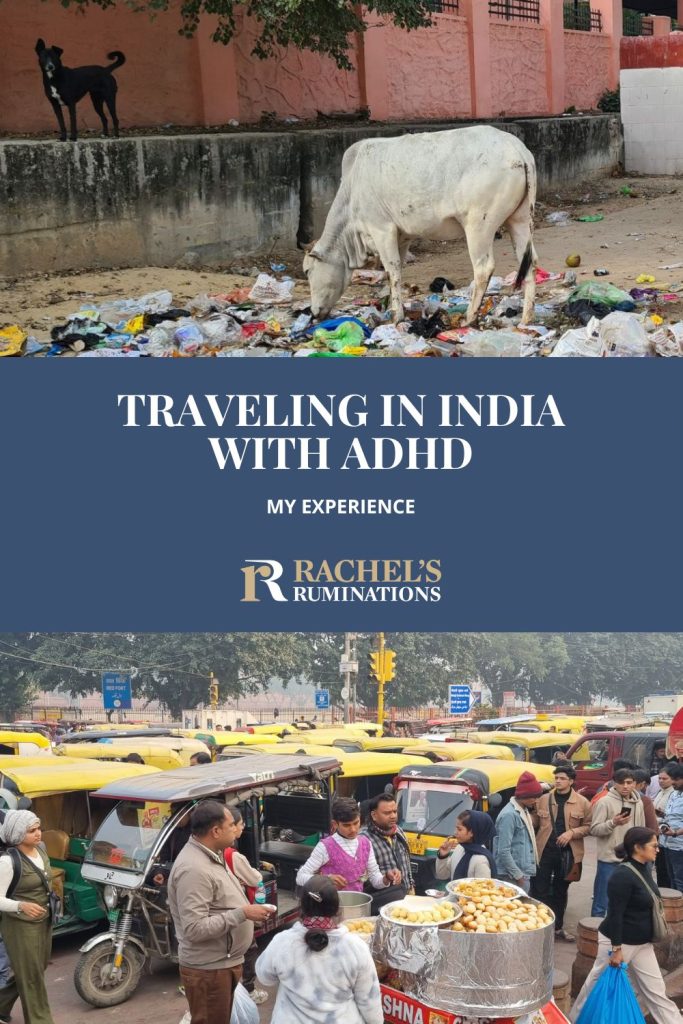
One of the things I’ve pieced together over the last two years is the many ways I’ve spent my whole life compensating for (and over-compensating for) my ADHD tendencies: my poor memory, my inability to organize pretty much anything, the way my mind jumps from topic to topic like a ping-pong ball, my occasional moments of hyperfocus when I miss everything that is happening around me, my inability to follow up on a resolution or plan of any sort, my social and physical clumsiness …
I could go on and on, but what I realized was that the reason I’ve managed to have any sort of success in my life is by overcompensating. And through constant anxiety that I will fail. Anxiety makes me worry I’ll mess it up, so I overcompensate.
Can’t manage to absorb the material you need to know for a test? Follow a note-taking strategy that helps you organize all that information in a way that seems to make sense, then read the notes and reread them and reread them again until, even though you still can’t actually remember everything, you can picture the page and the place on the page where the information is and find it that way.
Anxious about getting a college essay or a work assignment done on time because you might just forget to do it when you get distracted by something else? Start it weeks early, work on it far too long in an attempt to make it absolutely perfect (Perfectionism is a common side effect.) and get it done early. I think I was the only person in my graduating class at university who never pulled an all-nighter to get an assignment done.
Need to give a presentation? Prepare the PowerPoint weeks ahead. Keep tweaking it till it’s perfect – yet stay convinced it isn’t good enough. Practice giving the presentation repeatedly. When you finally give the presentation, no one will see any of that: they’ll see what appears to be a confident, relaxed person who’s just really good at public speaking.
And at the same time, constantly worry that the work you do isn’t good enough.
You get the idea. I even ended up in a profession – teaching – in which there’s constant distraction and hourly changes of environment, and where I didn’t have to sit still, but rather could move around the class, responding to students’ questions. The parts I struggled with – the overcompensation and anxiety – were hidden at home, where I spent far too long at my very messy desk, preparing my lessons and struggling to focus on grading assignments.
The term for this is “masking:” hiding what you’re feeling and going through. I have become a master at masking.
Traveling with ADHD
I’ve also realized the main reason I like travel so much. When I’m in a strange city, that ping-pong ball bouncing of my brain seems to settle down. I’m the most present when I’m walking down a street in a city that is new to me. I’m noticing everything: what people are wearing, the individual buildings and their architecture, the smells wafting around me, the sounds.
But rather than distracting and overwhelming me, those stimuli are what I am there for: to assuage my constant curiosity about other places, their cultures and history. I’m just in the moment, and the anxieties and need to compensate for my failures fade to the background. At home, I know my hometown so well that it doesn’t even get my attention anymore. There, when I walk around, my anxieties and insecurities come along with me.

Pre-travel planning
Planning travel, on the other hand, brings out all my ADHD-ness. Since I travel so much, especially since I gave up teaching to focus on my websites, I’ve developed strategies for dealing with it leading up to a trip.
I start packing weeks ahead. To be honest, I start thinking about what I’ll pack even further ahead. I leave my suitcase in my room, and I put things into it as I think of them. If I didn’t, I’d forget them again, as the ping-pong ball bounces somewhere else. Several days or even a week ahead, I’ll do my initial packing. Taking all the bits and bobs back out of the suitcase, I decide if I really want to take each one along. I’ll select the clothing that I want to take. Then, over the next several days, I’ll go over the contents of the bag repeatedly, usually just in my head, and without a doubt I’ll remember more things that I meant to take but forgot. Because I started so early, I can still add them.
By the way, I usually travel with carry-on bags only: one bag for the overhead compartment and a backpack under the seat in front of me. It’s certainly easier to have less to lug along when you move from place to place, but the real reason I do it is my anxiety about losing my checked luggage.
I also book flights, train trips and hotels months ahead. My husband hates this. He’d rather just make reservations as we go, or even just show up at a hotel to ask if they have rooms. He does not suffer anxiety about anything. I’ve only ever agreed to do this when we take road trips because I know that, if worse comes to worse, we can sleep in the car.
On the day of travel, I like to arrive at the airport four hours ahead – another thing that infuriates my husband, who is fine with aiming for one hour. I’m aware that this is completely unnecessary, but my anxiety makes me worry about trains being cancelled or huge delays at security at Schiphol, both of which have happened to me before. Once I get to the airport and know where the gate is, I can finally relax.
Planning for our India trip
All of this sort of came to a head on this trip in India. I booked everything ahead as usual, but with much more trepidation. For many hours over several months, I did battle with the Indian Railways website trying to book seats or bunks on trains. I knew we should travel first or second class, but I kept getting an error when I tried to reserve. Finally I hit on the booking site 12Go – which was stupid because I had used that site successfully last year for our trip in Thailand, yet I’d completely forgotten it existed. It worked easily.
To collect content for my World Heritage travel website, I planned the trip to enable us to visit lots of UNESCO sites across Delhi, Madhya Pradesh, Uttar Pradesh and Rajasthan. I also planned in two two-week stays: one in Jaipur and one in Udaipur. I knew I’d need breaks to write and to rest.
As I often do before travel, I made a Google map of the region and marked all the places my husband and I wanted to visit. Of course, I knew we wouldn’t be able to see them all, but it’s a strategy (overcompensation again) that helps me get my head around my plans. If you’re interested, here’s the resulting map. I’ve changed the pin colors to indicate which we actually visited. The purple ones are the places we did get to (One of them only my husband saw, not me.). The orange ones we didn’t see.
ADHD in India
First, a disclaimer: I am no expert on India and I’m aware that I approach my travel from a privileged and Western point of view. I’m not saying that what I experienced as unpleasant is necessarily bad, or that other places in the world are necessarily better. I’m just explaining how I experienced it.
What I couldn’t plan for, of course, was what it would actually feel like to be in India. I knew it would be loud and chaotic in Delhi, of course. I had been to Mumbai before just for a few days for a conference, so I’d seen that and expected it. But I didn’t know what smaller cities would be like. I had liked Mumbai. Looking back at that trip now, I realize I liked it because I was either busy with my workshop or, most of the time, being guided by a tour guide. And I could retreat to a very elegant five-star hotel whenever I wanted.
On this trip, the historical sites we visited – my favorite kind of destination – were fascinating, and often beautiful. But I only rarely got that feeling of being present that I’ve had pretty much everywhere else I’ve traveled. Why? Because my anxieties seemed to take wing.
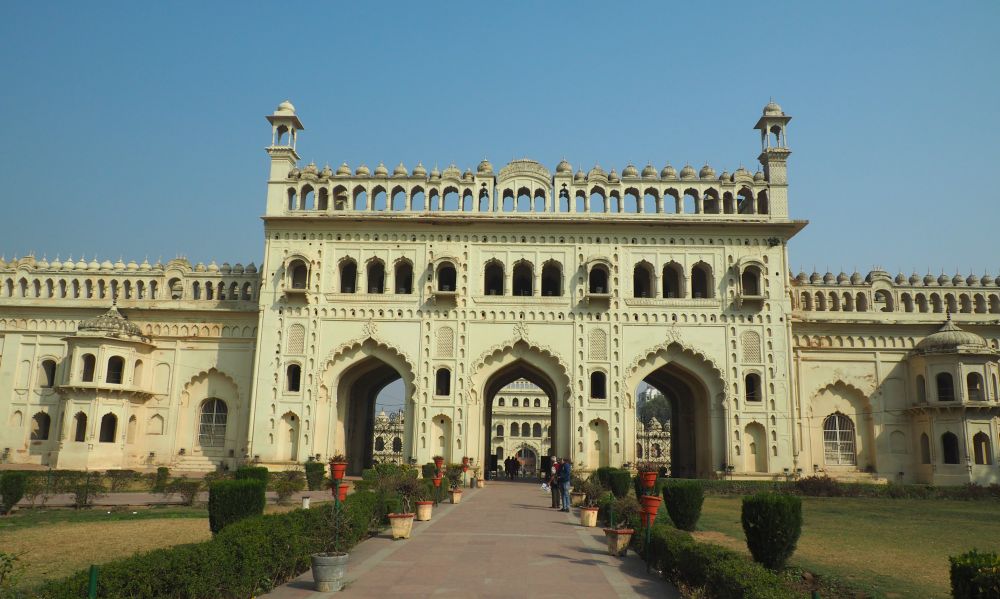
Noise
Indian cities – at least in the region we visited – are incredibly noisy. All day and well into the night, the cars and tuk-tuks honk. Constantly. At night, weddings snake through the streets, with drum corps playing and music blasting from portable speakers. And the dogs – both pets and strays – bark. A lot.
If you have ADHD, you know that noise, or really any excessive sensory input, is a problem. I don’t go to concerts anymore, for example, because the volume is just too high. My bedroom has to be quiet for me to sleep – or at least the noise needs to be constant and in the background. Earplugs don’t solve the problem because they bother me – that oversensitivity again – as much as noise does.
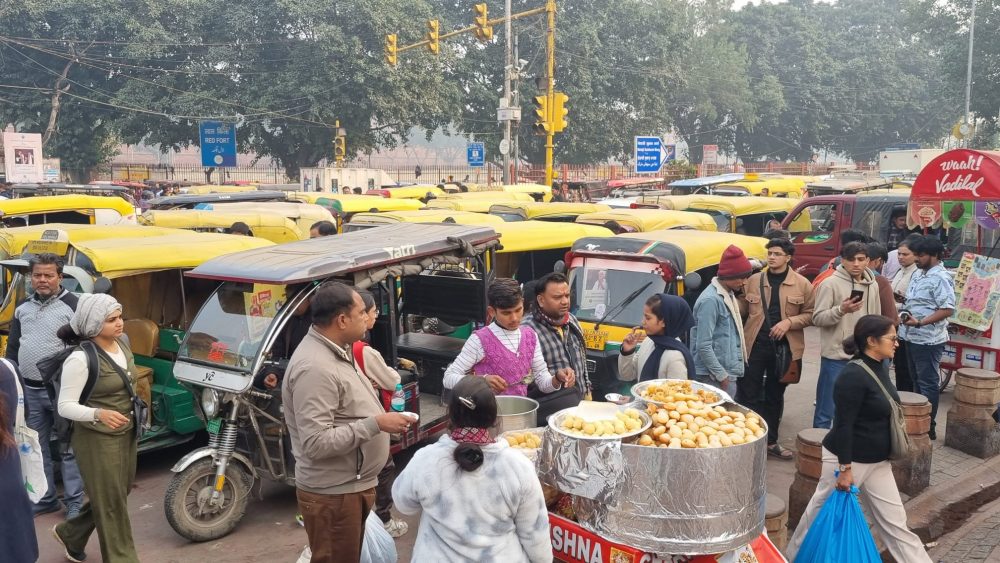
Traffic
Speaking of cars and tuk-tuks, the streets are full of traffic, and that traffic doesn’t seem to follow any rules except honking a lot. That wouldn’t be too much of a problem, except that sidewalks are either non-existent or blocked by parked vehicles, particularly motorbikes. That, in turn, forces pedestrians to walk along the edge of the traffic, and that traffic can get ridiculously close.
So that feeling of being present really only happened when I was at a historic site and away from traffic. I felt it when I toured Amber Fort, for example, or the three UNESCO sites in Delhi. But walking down the street? No. I was too busy being worried that I’d be hit by a motorbike, tuk-tuk or car. And jumping when any of them honked near me, for fear they were honking at me. (They weren’t.)
I was also watching for patches of attainable sidewalk, so I could walk on it at least till the next blockage. And on both the edge of the road and on the short bits of sidewalk, I was mostly watching my feet in order to avoid turning an ankle – something I often do if I’m not careful.

Crossing the street was out-and-out terrifying, and I don’t think that’s an ADHD thing. Anyone would find this anxiety-producing, if they weren’t used to it. Crosswalks seem to be meaningless in India. They exist but are completely ignored. Crossing the street means simply stepping out into it and trusting the traffic to flow around you. It works – I saw lots of people do it. But I Simply. Could. Not. My husband got the hang of it quickly, so he took to just grabbing me by the hand and guiding me along.
Smells
My kids call my sense of smell my superpower. Now I know that being hypersensitive – all senses, not just smells – can be part of ADHD. It’s part of why I’m so easily distracted – I can’t filter out sensations like neurotypical people.
India has many more, less familiar, and stronger odors than my home city in the Netherlands. There are cows wandering the streets, as well as dogs. They smell, and so does their poop. In some places, gutters run with what smells like a mix of chemicals and sewage. The exhaust from all that traffic adds its taint to the mix. In undisturbed corners, piles of garbage fester – the rotting garbage odor is sometimes very strong. In the shopping areas, the street food adds distinctly better smells. It was the amalgamation, though, of all these ever-shifting odors that felt overwhelming.
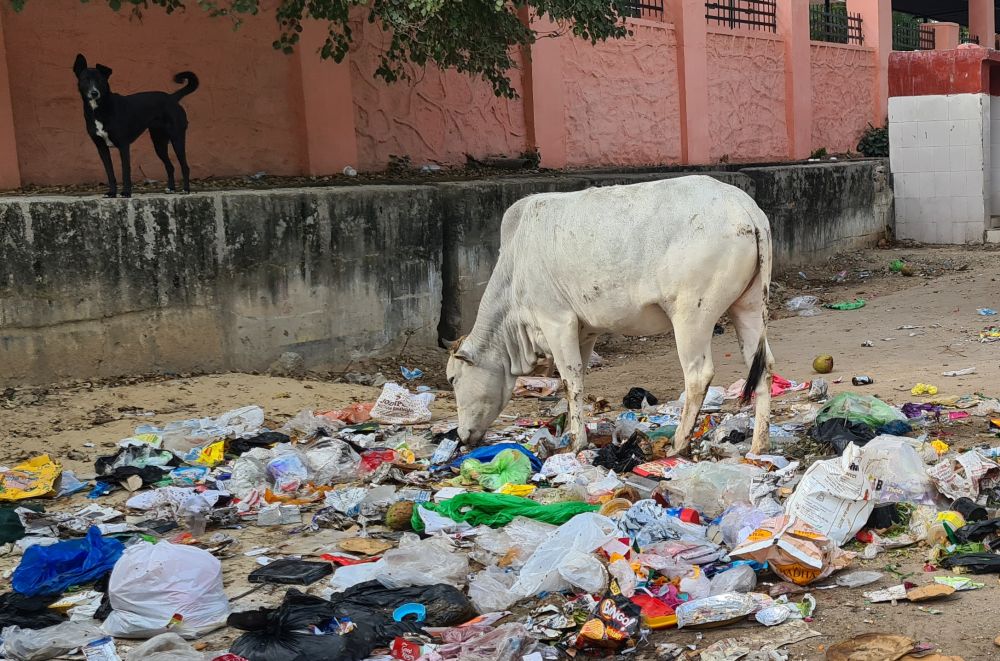
Sights
The bigger cities we visited had some places that were pretty – the old parts of Jodhpur, Jaisalmer and Jaipur, for example, and the part of Agra that has been polished up for tourists (real sidewalks!) near the Taj Mahal. We particularly liked Jaisalmer, with its yellow-sandstone havelis.
But a lot of areas aren’t pretty: the buildings are old and need cleaning and/or repair and there’s garbage everywhere. And when I say the buildings are old, that can mean just a decade or two, but unmaintained. Or it can mean a hundred years or more, but badly in need of renovation.
At the same time, I was constantly distracted by the saris and other traditional outfits that many women wear. They are magnificent. The colors are wonderful, and I love the way they match patterns – one pattern on the main sari and a different one on the edging or on their headscarf. It made me wish I could wear a sari and not look like a culturally-appropriating fool.
How I dealt with it
One of the things I decided well before this trip and my diagnosis was that I was going to start paying attention to my feelings of overwhelm and stop masking.
Well, that’s easier said than done when you’ve spent your whole life masking. In India, I tried to be aware of how I was feeling and started simply telling my husband when I’d had enough. I still wanted to see lots of historical sites, but perhaps I would have to see fewer of them.
The pattern tended to be that once we had spent a morning at a palace or fortress or museum or whatever, I’d had enough. Rather than masking that feeling and trying to fit another destination into the afternoon – which is what I would have done in the past – I would just stop.
But first, we would eat lunch. We always ate inside in a sit-down restaurant: calmer and quieter than being out on the street. After lunch, I would head back to the hotel. My husband would happily spend the rest of the day wandering the city, soaking in the atmosphere that he didn’t find overwhelming at all.
At the hotel, I’d write notes on what I’d seen, or I’d just hang out and doom-scroll. It didn’t matter; at the hotel I felt safe. While I could often still hear lots of noise from the street outside, the door was locked and I was away from that overstimulation. Sometimes I would fall asleep, which isn’t really surprising considering how poorly I was sleeping at night.
I’d venture out again with my husband to eat dinner, but always we’d find somewhere to eat very close by. If it was anxiety-producing to walk outside in the daytime, it was even worse in the evening when the streets are busier but pedestrians are harder to spot.
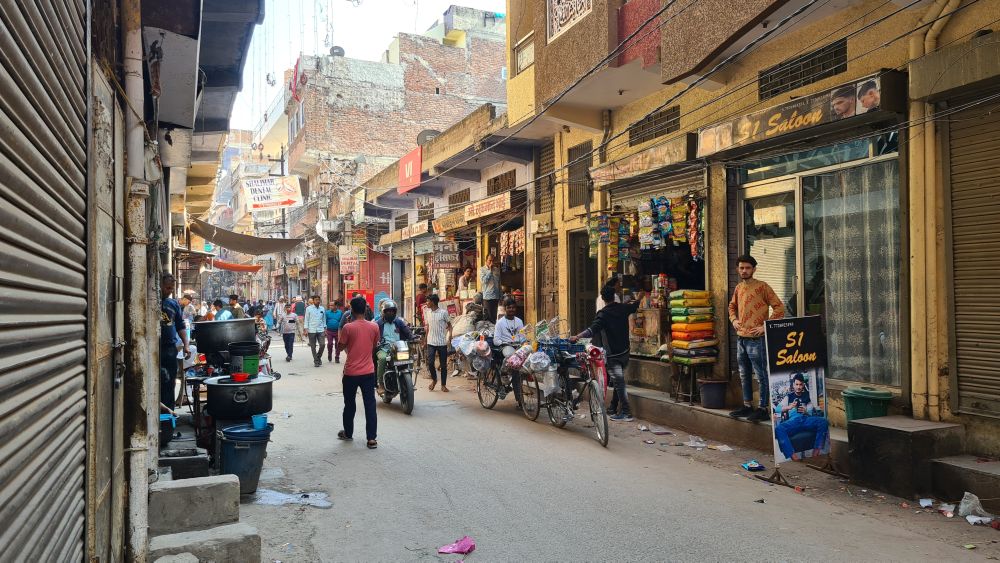
Tips for traveling in India with ADHD
I’m not sure if I’m qualified to give any tips for traveling in India with ADHD, but I’ll try anyway. I was only there for two months – I’m not an expert on either ADHD or on India. I guess my best advice at this point in my ADHD “journey” is to follow how you feel. Stop compensating and stop masking and get in touch with what you actually want to do or not do.
Taking a tour?
That probably means you shouldn’t sign up with a group tour. These tend to pack lots of sights into each day and you’ll have no choice but to go along.
What would work best would probably be a private tour, if you can afford it. That way you wouldn’t have to worry about booking trains or planes or hotels or anything. You could let a bespoke tour operator set up a tour that hit the things you want to see but allowed plenty of down time in your hotel room. Bespoke tours are generally flexible too. You can change the plan or cut a tour short if you need to retreat. On this trip, we had a sampling of the bespoke tours that Travel XS offers, and they certainly make things easier.
If you can’t spring for a complete multi-day tailor-made tour, sign up for private walking tours in each new city, or hire someone to take you to any sights outside of town. Then you can ask as many questions as you want and stop or take breaks when you decide you need it. In India the prices are quite reasonable, but always remember to tip your guide and/or driver as well.
Choosing hotels
Choose your hotels carefully. Being in the old part of a city can mean a lot of noise because of weddings or just because the streets are narrow and traffic sounds travel upward. A hotel on a side street, especially if it’s on an alleyway, is likely to have less traffic noise at night. If you can afford it, choose a fancy, modern five-star hotel that has insulated windows with quiet air conditioning. Read the reviews carefully for hints about noise levels.
In Delhi, we stayed in a small guesthouse called Two Green Park, which I highly recommend. It’s in a section south of the center called Green Park. The guesthouse is in a high-end gated community of well-kept apartment houses, and there’s almost no noise at night. The streets are swept every day as well. It was a huge relief after staying in so many noisy places. And it’s just a few blocks’ walk to a metro station.
Other tips
In the cities that have them, take the metro instead of a taxi or tuk-tuk. The metros are relatively clean, much quieter, better for the environment, and cheaper. The one in Delhi is the oldest and gets quite crowded, but it’s still better than being in the traffic. The Agra one is very new and only covers a short distance so far. Hardly anyone is using it yet, but it does link up the two main sights: the Taj Mahal and the Red Fort.
Of the cities we visited, Udaipur was the cleanest and quietest. The streets get swept regularly and there’s much less honking. The smallest town we stayed in was Khajuraho. It was quieter than any city, though dogs barking through the night still disturbed our sleep. I suspect that in general the smaller the town, the quieter.
Bring whatever will make you most comfortable. That might be earplugs or headphones, for example, if you’re comfortable sleeping in them. One thing that I will bring on future trips is a pillowcase because the feel of the pillowcases in some hotels bothered me.
I haven’t been there yet, but quite a few people have told me that there are places in the south that are prettier and quieter, particularly in the state of Kerala. Since, despite all that I’ve said above, I find Indian history and culture very interesting, I’d like to take another try at it in the south someday.
I’d love to hear from anyone with similar or different experiences with traveling in India with ADHD. Have you been to India and do you have ADHD? How was it for you? Do you have any additional advice for anyone reading this who’s planning an India trip? Please leave your thoughts in the comment section below!
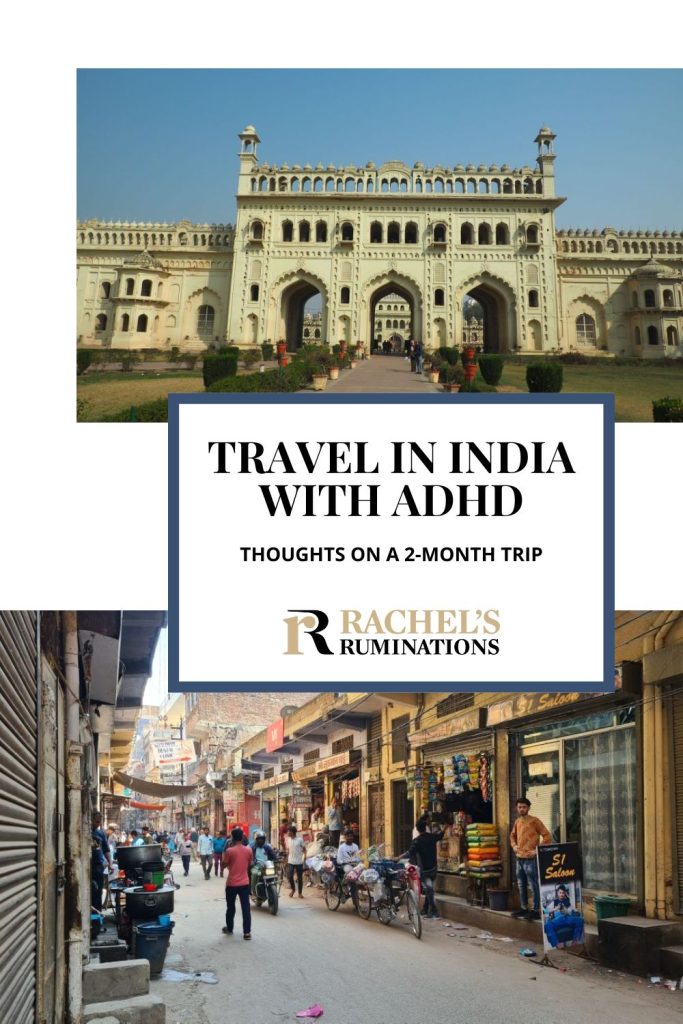
My travel recommendations
Planning travel
- Skyscanner is where I always start my flight searches.
- Booking.com is the company I use most for finding accommodations. If you prefer, Expedia offers more or less the same.
- Discover Cars offers an easy way to compare prices from all of the major car-rental companies in one place.
- Use Viator or GetYourGuide to find walking tours, day tours, airport pickups, city cards, tickets and whatever else you need at your destination.
- Bookmundi is great when you’re looking for a longer tour of a few days to a few weeks, private or with a group, pretty much anywhere in the world. Lots of different tour companies list their tours here, so you can comparison shop.
- GetTransfer is the place to book your airport-to-hotel transfers (and vice-versa). It’s so reassuring to have this all set up and paid for ahead of time, rather than having to make decisions after a long, tiring flight!
- Buy a GoCity Pass when you’re planning to do a lot of sightseeing on a city trip. It can save you a lot on admissions to museums and other attractions in big cities like New York and Amsterdam.
- Ferryhopper is a convenient way to book ferries ahead of time. They cover ferry bookings in 33 different countries at last count.
Other travel-related items
- It’s really awkward to have to rely on WIFI when you travel overseas. I’ve tried several e-sim cards, and GigSky’s e-sim was the one that was easiest to activate and use. You buy it through their app and activate it when you need it. Use the code RACHEL10 to get a 10% discount!
- Another option I just recently tried for the first time is a portable wifi modem by WifiCandy. It supports up to 8 devices and you just carry it along in your pocket or bag! If you’re traveling with a family or group, it might end up cheaper to use than an e-sim. Use the code RACHELSRUMINATIONS for a 10% discount.
- I’m a fan of SCOTTeVEST’s jackets and vests because when I wear one, I don’t have to carry a handbag. I feel like all my stuff is safer when I travel because it’s in inside pockets close to my body.
- I use ExpressVPN on my phone and laptop when I travel. It keeps me safe from hackers when I use public or hotel wifi.




Really sorry to learn this. Although I haven’t got ADHA, I’ve recognised these traits in both children and adults.
Putting things in my suitcase two weeks before travelling is something I’ve done for years. I always think I’m going to forget the most important items. Strangely, half of them are not needed.
You must feel relieved to to have a description for your symptoms and I do hope you’re able manage ADHD well.
Thank you, but it’s not something to be sorry about. Well, perhaps that I didn’t figure it out sooner. It just is. I’ve started medication and am seeing some improvement, and the ADHD organization here has various other ways they’ll help. It is a definite relief to at least have an explanation!
hello!
pls do come to Kerala where you can enjoy our backwaters in Aleppey or Kumarakom.. i promise it is quieter and more laid back, with 5-star hotels too.
I’ve heard that from lots of people – that Kerala would work better for me. Next time! Thank you!